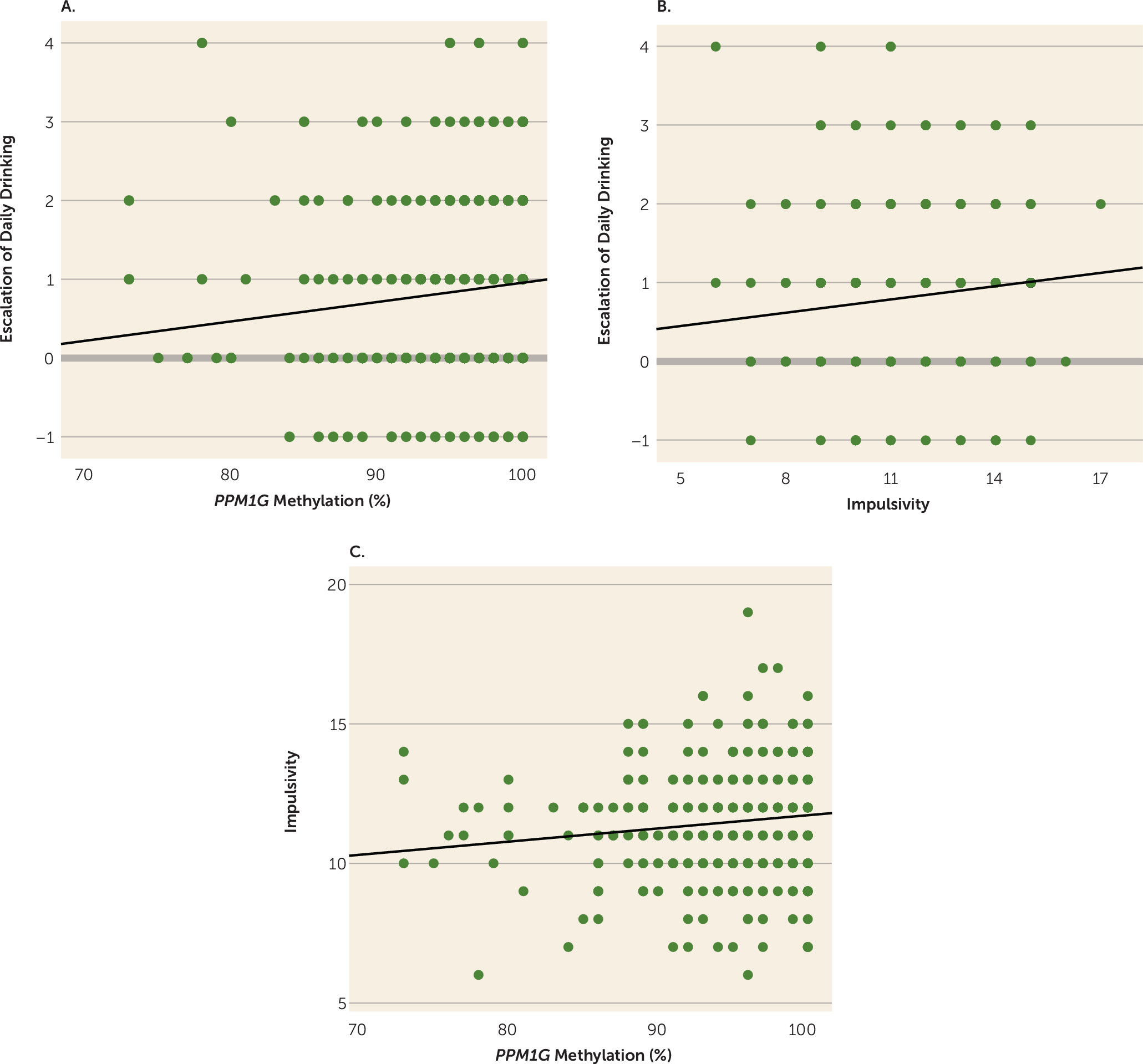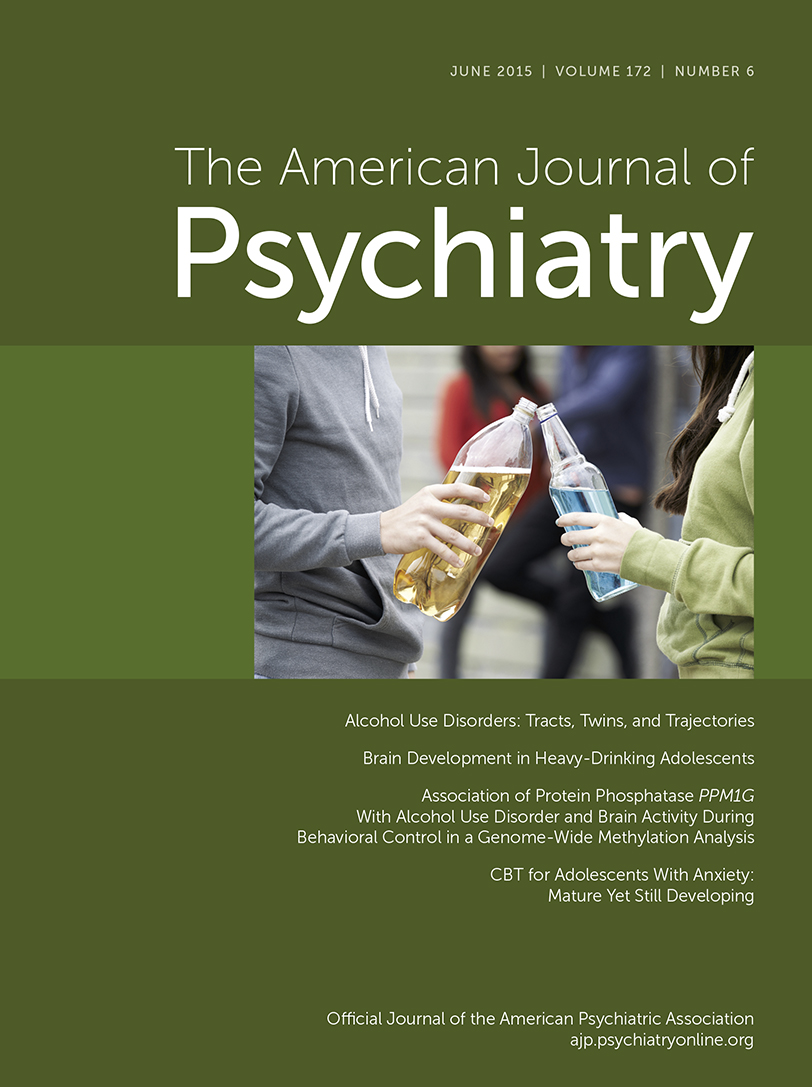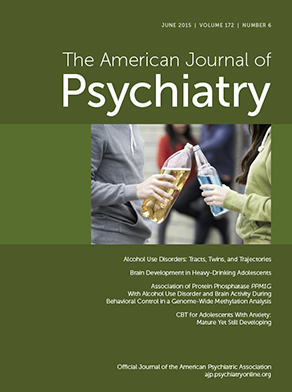Association of Protein Phosphatase PPM1G With Alcohol Use Disorder and Brain Activity During Behavioral Control in a Genome-Wide Methylation Analysis
Abstract
Objective:
Method:
Results:
Conclusions:
Method
FinnTwin16 Study Participants
| Sample and Characteristica | ||
|---|---|---|
| Twin pairs discordant for alcohol use disorder at age 24 | N | % |
| Male | 7 | 38.9 |
| Alcohol dependence diagnosis | 16 | 88.9 |
| Alcohol abuse diagnosis | 2 | 11.1 |
| Mean | SD | |
| Number of DSM-III-R symptoms in the twin without a substance use diagnosis | 1.6 | 0.26 |
| Number of DSM-III-R symptoms in the twin with a substance use diagnosis | 3.5 | 0.22 |
| Adolescent sample | N | % |
| Male | 222 | 44.5 |
| Mean | SD | |
| Development score at age 14 (Pubertal Development Scale) (N=399) | 2.88 | 0.56 |
| Increase in daily amount of drinking (European School Survey Project on Alcohol and Other Drugs) (N=353) | 0.83 | 1.06 |
| Impulsivity at age 16 (Substance Use Risk Profile Scale) (N=399) | 14.02 | 2.75 |
| Sensation seeking at age 16 (Substance Use Risk Profile Scale) (N=399) | 11.48 | 2.02 |
Genome-Wide Methylation Assay
Analysis of the Array
Verification of Alcohol Use Disorder-Associated Differentially Methylated Regions
IMAGEN Study Participants
Behavioral Characterization
PPM1G Methylation Analysis
Stop Signal Task
Functional MRI Data Acquisition and Analysis
PPM1G Gene Expression and Genotype Analysis
Association Analyses
Results
Genome-Wide Analysis of Differentially Methylated Genes in Monozygotic Twins Discordant for Alcohol Use Disorder
| Gene (Nimblegen Identification Number) | Gene Symbol | pfpa | Location | CpGb Context |
|---|---|---|---|---|
| Top hypermethylated regions (p<1×10–5) | ||||
| Protein phosphatase 1G (CHR02P027457864) | PPM1G | <1×10–5 | Body | Shore |
| Insulin- insulin-like growth factor 2 (CHR11P002137905) | INS_IGF2 | <1×10–5 | Body | Shelf |
| NA (CHR05P064022468) | NA | 3×10–4 | Intergenic | Island |
| Nucleosome assembly protein 1-like 2 (CHRXP072351512) | NAP1L2 | 3×10–3 | Body | Open sea |
| Solute carrier family 6 (neurotransmitter transporter, dopamine), member 3 (CHR05P001469753) | SLC6A3 | 4×10–3 | Body | Shore |
| Hypothetical protein LOC149840 (CHR20P005679048) | NA | 4×10–3 | Body | Open sea |
| Ubiquitin-conjugating enzyme E2M pseudogene 1 (CHR16P034261914) | UBE2MP1 | 6×10–3 | Body | Shore |
| Absent in melanoma 1 (CHR06P107065946) | AIM1 | 7×10–3 | Body | Shore |
| NA (CHR09P069075112) | NA | 7×10–3 | Intergenic | Island |
| Opioid receptor-like 1 (CHR20P062188944) | OPRL1 | 7×10–3 | Body | Island |
| Top hypomethylated regions (p<1×10–5) | ||||
| Neurotrophic tyrosine kinase, receptor, type 1 (CHR01P155095309) | NTRK1 | >1×10–5 | Body | Shore |
| NA (CHR02P095678989) | NA | >1×10–5 | Intergenic | Shore |
| Formin 1 (CHR15P031274371) | FMN1 | >1×10–5 | Body | Island |
| Selenophosphate synthetase 2 (CHR16P030364503) | SEPHS2 | >1×10–5 | Body | Island |
| Myocyte enhancer factor 2D (CHR01P154736441) | MEF2D | 3×10–4 | Body | Island |
| 6-phosphofructo-2-kinase/fructose-2,6-biphosphatase 3 (CHR10P006245627) | PFKFB3 | 3×10–4 | Body | Island |
| Solute carrier family 45, member 4 (CHR08P142298123) | SLC45A4 | 4×10–4 | Body | Island |
| L-pipecolic acid oxidase (CHR17P024393350) | PIPOX | 4×10–4 | Body | Open sea |
| Fibroblast growth factor (acidic) intracellular binding protein (CHR11P065412364) | FIBP | 2×10–3 | Body | Island |
| MIRLET7B host gene (nonprotein coding) (CHR22P044859950) | MIRLET7BHG | 2×10–3 | Body | Open sea |
Association of PPM1G Methylation, Gene Expression, and Genotype
Association of PPM1G Methylation With Drinking Escalation and Trait Impulsiveness

Association of PPM1G Methylation and Activation of the Subthalamic Nucleus During a Behavioral Inhibition Task

Discussion
Footnote
Supplementary Material
- View/Download
- 477.45 KB
References
Information & Authors
Information
Published In
History
Authors
Author Contributions
Funding Information
Metrics & Citations
Metrics
Citations
Export Citations
If you have the appropriate software installed, you can download article citation data to the citation manager of your choice. Simply select your manager software from the list below and click Download.
For more information or tips please see 'Downloading to a citation manager' in the Help menu.
View Options
View options
PDF/EPUB
View PDF/EPUBLogin options
Already a subscriber? Access your subscription through your login credentials or your institution for full access to this article.
Personal login Institutional Login Open Athens loginNot a subscriber?
PsychiatryOnline subscription options offer access to the DSM-5-TR® library, books, journals, CME, and patient resources. This all-in-one virtual library provides psychiatrists and mental health professionals with key resources for diagnosis, treatment, research, and professional development.
Need more help? PsychiatryOnline Customer Service may be reached by emailing [email protected] or by calling 800-368-5777 (in the U.S.) or 703-907-7322 (outside the U.S.).

